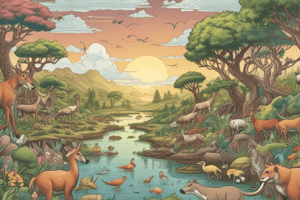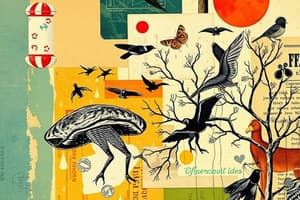Podcast
Questions and Answers
Which of the following is NOT a component of a food chain?
Which of the following is NOT a component of a food chain?
Food webs are simpler and more linear than food chains.
Food webs are simpler and more linear than food chains.
False (B)
What is the primary role of decomposers in an ecosystem?
What is the primary role of decomposers in an ecosystem?
Decomposers break down dead organisms and waste, returning nutrients to the soil for producers to use. They are essential for nutrient cycling, ensuring the sustainability of ecosystems.
The transfer of energy from producers to consumers in a food chain is ______ efficient.
The transfer of energy from producers to consumers in a food chain is ______ efficient.
Signup and view all the answers
Match the following terms with their definitions:
Match the following terms with their definitions:
Signup and view all the answers
What is the most likely consequence of removing a top predator from a food web?
What is the most likely consequence of removing a top predator from a food web?
Signup and view all the answers
Human activities have no impact on food webs and chains.
Human activities have no impact on food webs and chains.
Signup and view all the answers
Explain how the complexity of food webs contributes to ecosystem stability.
Explain how the complexity of food webs contributes to ecosystem stability.
Signup and view all the answers
Flashcards
Food Chain
Food Chain
A linear sequence showing how organisms feed on each other, transferring energy from producers to consumers.
Food Web
Food Web
A complex network of interconnected food chains representing feeding relationships in an ecosystem.
Producers
Producers
Autotrophic organisms that create their own food using sunlight, water, and carbon dioxide.
Primary Consumers
Primary Consumers
Signup and view all the flashcards
Secondary Consumers
Secondary Consumers
Signup and view all the flashcards
Trophic Levels
Trophic Levels
Signup and view all the flashcards
Decomposers
Decomposers
Signup and view all the flashcards
Energy Flow
Energy Flow
Signup and view all the flashcards
Study Notes
Scientific Concepts of Food Chains and Webs
- Food chains depict a linear sequence of organisms, where each feeds on the one below it. Energy flows in a single direction from the base (producers) to the top (consumers).
- Food webs represent a more complex and realistic portrayal of feeding relationships in an ecosystem. They illustrate multiple interconnected food chains, showing the intricate feeding habits amongst various species.
Components of Food Chains/Webs
- Producers: Autotrophic organisms (e.g., plants, algae) that produce their own food through photosynthesis using sunlight, water, and carbon dioxide. They form the base of the food chain/web.
- Primary consumers: Herbivores that feed directly on producers (e.g., deer feeding on grass).
- Secondary consumers: Carnivores that feed on primary consumers (e.g., a wolf feeding on a deer). They can also be omnivores if they eat both plants and animals.
- Tertiary consumers: Carnivores that feed on secondary consumers (e.g., a lion feeding on a wolf).
- Decomposers: Organisms (e.g., bacteria, fungi) that break down dead organic matter, returning nutrients to the ecosystem. They play a crucial role in nutrient cycling.
Energy Flow
- Energy flows from producers to various consumers in a food chain/web. Each transfer is inefficient, with a significant portion of energy lost as heat to the surrounding environment.
- At each trophic level (feeding level), only a fraction of the energy is transferred to the next level. Pyramid of energy demonstrates this transfer loss visually.
Trophic Levels
- Trophic levels describe an organism's position in the food chain/web based on its feeding habits. Producers are at the first trophic level.
Nutrient Cycling
- Decomposers play a vital role in nutrient cycling by breaking down dead organisms. They return essential nutrients (like nitrogen and phosphorus) to the soil, making them available for producers. This continuous recycling is a key aspect of ecosystem sustainability.
Food Web Complexity
- Food webs are complex networks. Multiple organisms may feed on the same food source, and a single organism may consume various foods.
- The presence of multiple food sources and consumers increases the stability of the ecosystem.
Impact of Human Activity
- Human activities can disrupt food chains and webs. For example, pollution can harm producers and consumers, and overfishing can deplete fish populations, impacting the entire ecosystem.
Keystone Species
- A keystone species is a species that has a disproportionately large effect on its environment relative to its abundance. Their removal can result in significant ecosystem changes.
Biomass
- Biomass refers to the total mass of living organic matter in a given area or trophic level. Biomass pyramids illustrate the mass of organisms at each trophic level.
Ecological Pyramids
- Ecological pyramids, such as pyramids of numbers and biomass, can visually illustrate relationships in food webs and highlight the energy and biomass transfer at different trophic levels.
Studying That Suits You
Use AI to generate personalized quizzes and flashcards to suit your learning preferences.
Description
Explore the key concepts of food chains and food webs in ecosystems. This quiz covers the roles of producers, primary consumers, secondary consumers, and tertiary consumers. Test your understanding of these essential ecological relationships and their significance in energy flow.




